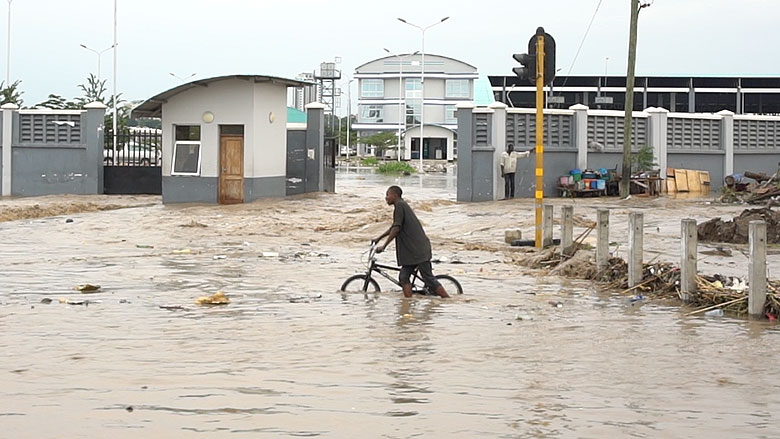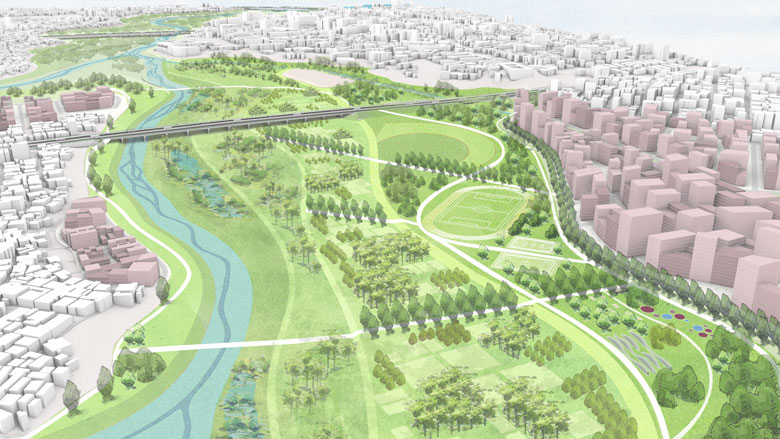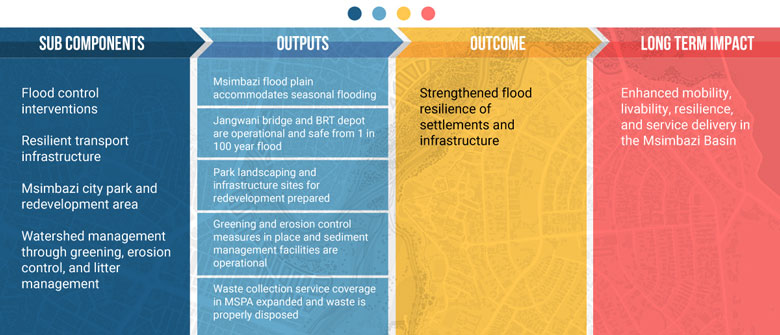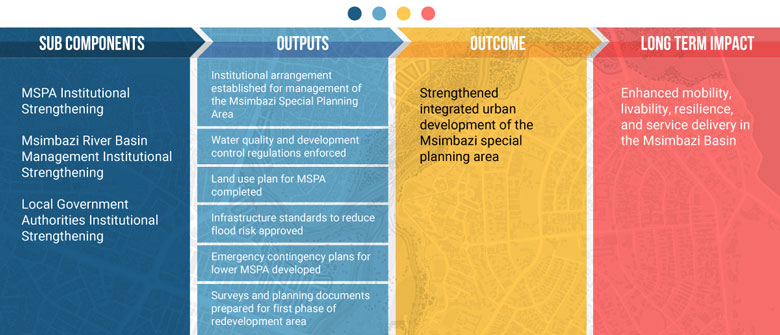The Msimbazi River Basin is an economically, geographically, and environmentally significant region, home to about 1.6 million people and critical transportation infrastructure that connects the Central Business District of Tanzania's most populous city, Dar es Salaam, with the rest of the city. But flooding has become increasingly severe over the past decade, with major flood events experienced in seven out of the last 10 years. These events are expected to increase with urbanization and climate change.
The Government of Tanzania, with a $200 million credit from the World Bank Group’s International Development Association (IDA), established the Msimbazi Basin Development Project (2022-2028) to strengthen flood resilience and integrate urban development efforts in this economically important and flood-prone area of Dar es Salaam. The project is anticipated to benefit from $60 million worth of credit from the Spanish Agency for International Development Cooperation and a grant from the Netherlands Ministry of Foreign Affairs through Invest International.

1: Msimbazi River Basin Development Infrastructure |
Improvements to the watershed environment will help mitigate the impact of floods, helping to protect people, the environment, and transportation infrastructure. |
2: Preventative resettlement of flood-prone communities |
Moving vulnerable populations from harm's way and providing resources to support the community will reduce risk to human life and health. |
3: Strengthening institutions for resilient urban development |
Governance reforms and support for strengthening new and existing institutions will help support ongoing management of Msimbazi River Basin.
|
4: Project Management |
This component will finance the direct costs of management and operation of the project to ensure smooth delivery and compliance with World Bank policy and guidelines. |
5: Contingency Emergency Response |
Financing for rapid response for eligible emergencies and disasters caused by natural and man-made. |
The project will transform the flood-prone but economically important lower Msimbazi River Basin of Dar es Salaam through a set of integrated investments that aim to reduce the impact of flooding, catalyze sustainable urban development, and improve livability.
Increasingly frequent, severe floods: Over the past decade, the middle and lower part of the Msimbazi Basin has been experiencing frequent, severe flooding at least twice a year during every rainy season. In 2019 alone, nine major flood events took place. This flooding adversely impacts the people, infrastructure, economy, and environment of Dar es Salaam.
Growth pressures putting more people in harm's way: Msimbazi used to be an open wetland, absorbing and channeling rainwater into the ocean during the rainy season while serving as open, public space suitable for sports and public meetings during the dry season. But cheap land and proximity to the Central Business District has increased urbanization pressures and encroachment has destabilized river banks, increased erosion and putting about 50,000 people from the most vulnerable communities in the path of floodwaters.
Human influences on river health: Human activities have caused the river's channel to shift, while sedimentation has reduced its depth and ability to absorb flood impact. Storm water infrastructures, including bridges, are inadequate and mostly blocked by sediments and solid waste.
Four major challenges contribute to flood risk:
Citizens in the city of Dar es Salaam will benefit from the project in a number of ways:
A long-term solution will substantially reduce the impacts of floods and in the lower Msimbazi River Basin, improving hydraulic capacity of the river, providing an area for flood water detention, building resiliency of key transport infrastructure, regenerating valuable land assets to control encroachment in flood-prone areas while allowing for public recreation and urban development and reducing degradation of the Msimbazi watershed.

Flood control interventions will:
Subcomponent 1.1: Flood control interventions
This subcomponent will address key priorities for flood control infrastructure in the Lower Msimbazi Basin. The investments aim to improve the degraded river channel, recontouring the river and flood plain to improve flow capacity and allow for floodwater retention. Key investments include, inter alia: (a) river channeling, excavation of the flood plain, and construction of a multi-level flood retention area; (b) river-bank protection works; (c) sediment management activities including the construction of river maintenance depots; sediment and litter traps; equipment and operational costs; (c) construction supervision; and, (d) designs for future interventions.
Subcomponent 1.2: Resilient transport infrastructure
This subcomponent will upgrade key transport infrastructure in the project area to protect existing public transit assets and minimize disruptions during the rainy season, incorporating climate and disaster-resilient designs. Key investments include: (a) widening and raising the Jangwani Bridge to accommodate flash flood events, including upgrading it to a multi-span bridge, raising embankments and improving stormwater conveyance including construction supervision; (b) demolishing existing BRT bus depot facilities and construction of a new bus depot; and (c) upgrading existing bridges and roads in Msimbazi River Basin to improve hydraulic conveyance and connectivity in the river basin.
Subcomponent 1.3: Msimbazi city park and redevelopment area
This subcomponent will finance interventions to implement and sustain the land uses in the flood retention area in the Lower Msimbazi River Basin to reduce the risk of encroachment and allow for recreational and low-carbon and resilient real estate development. Key investments include: (a) Carrying out a Msimbazi wetland and city park development, including greening and mangrove revitalization, utilities infrastructure and equipment, street and pathways, facilities and buildings, sports and recreation facilities, and market areas; (b) constructing sites as well as green and resilient ancillary service infrastructure (e.g. roads, street lighting, drainage, wastewater management infrastructure, etc.) to enable a mixed-income, mixed-used urban development.
Subcomponent 1.4: Watershed management through greening, erosion control, and litter management
This subcomponent will focus on nature-based solutions and improved urban services to address the environmental and social challenges that contribute directly to the reduced carrying capacity of the river through restoring natural assets and reducing waste in the river. Key investments include: (a) upstream reforestation program; (b) implementing erosion prevention and greening including reinforcement of riverbanks, urban greening along riverbanks and tributaries and communications program; (c) construction of sandtraps in upstream areas; (d) implementing a community solid waste management program including provision of equipment, construction of materials recovery facilities, implementing design and communications greenhouse gas emissions through recycling; and, (e) results based financing for improved solid waste collection and recycling.
The expected outcomes

This component will finance the carrying out of preventive resettlement of low-income flood-prone communities in the lower Msimbazi River Basin. An estimated 6,356 Project Affected Households, including 3,780 owners and 2,576 tenants, with a total of 3,564 project-affected people (PAP) will be relocated to safe areas. The resettlement includes:
Subcomponent 2.1: Resettlement Compensation
This subcomponent will finance resettlement compensation for flood-prone households. The eligible compensation is defined under the Resettlement Action Plan based on the entitlements provided in the Resettlement Policy Framework and are consistent with the World Bank Environmental and Social Standards.
For those that will be relocated from the flood prone area, the options provided would minimize livelihood disruption and provide secure land in non-flood prone areas. They include provision of housing and land located in the Dar es Salaam Metropolitan area.
Several areas are nearby the current area while others are within 10 km away and provided with supporting services and land tenure. A structured consultation and outreach program will provide the PAPs informed choices and support the process of implementation of the program. This subcomponent will finance all the compensation provided under the Resettlement Action Plan including but not limited to: (i) housing materials, construction, and service infrastructure; (ii) cash compensation; (iii) land purchase; and (iv) legal, financial and other related fees.
Subcomponent 2.2: Livelihood Restoration
This subcomponent will finance a Livelihood Restoration Program that will be implemented in parallel with Resettlement Action Plan compensation and relocation. Ninety percent of PAP to be resettled earn livelihoods in the informal economy, largely petty trading and vending, and livelihoods are dependent on their current location near the Dar es Salaam central business district. Relocation from the area could impact PAP livelihoods. The livelihood restoration program was designed to complement the relocation of households from flood-prone areas and ensure that PAP livelihoods are maintained at/or above pre-project level. This subcomponent will finance consultant services, equipment and works, and training related to the implementation of this program.
The expected outcomes

This component focuses on governance reforms, strengthening new and existing institutions, building capacity and facilitating coordination for management of the Msimbazi River Basin, including the investments and assets created under the project, the surrounding urban area, and the watershed.
Institutional strengthening will:
Subcomponent 3.1: MSPA Institutional Strengthening
This subcomponent will support the formation of the institutional arrangements and management plans for the Msimbazi Special Planning Area (MSPA) and executing the land use planning, real estate transactions, city park and future development. Specifically, it will provide advisory support and analytics for: (a) establishment of institutional structure, management plan and financing for the management of the MSPA; (b) development of land use plan(s) for the MSPA; (c) preparation and transaction of real estate development (e.g. cadastral surveys, deed plans, land titles and development control enforcement; bidding and sale contract development; and transaction services).
Subcomponent 3.2: Msimbazi River Basin Management Institutional Strengthening
This subcomponent will support a multi-agency and stakeholder approach to manage the flooding and erosion and broader sustainability of the Msimbazi River Basin. Specifically, it will include:
(a) Strengthening infrastructure design to support flood and erosion control in the Msimbazi River Basin; (b) enhancing enforcement of water quality regulations through pollution inventories, regular monitoring, industry audits, identifying options for controlling pollution, and capacity building for long term monitoring; (c) Development of a watershed management plan; (d) strengthening arrangements for operation of dredging and sediment management; (e) development of emergency contingency plans for lower MSPA; (f) monitoring of mangroves and (g) purchase and installation of hydro metrological and river flow monitoring equipment.
Subcomponent 3.3: Local Government Authorities Institutional Strengthening
This subcomponent will provide institutional strengthening of the Dar es Salaam Local Authorities to support service delivery, urban planning and development controls, in support of their associated roles in the Msimbazi Special Planning Area, surrounding urban areas and watershed.
Specifically, this subcomponent will: (a) provide training, and technical assistance for monitoring and development of procedures and processes for enforcement of development controls; (b) provide technical assistance for the development of an upgrading plan for existing communities in lower MSPA; and, (c) provide technical assistance for improved management of solid waste services.
The expected outcomes

This component will finance the direct costs of management and operation of the project to ensure smooth delivery and compliance with World Bank policy and guidelines. Specifically, it will finance the carrying out project-management and coordination activities, through the establishment, maintenance, and operation of a Project Steering Committee, and coordination and implementation teams. This component will ensure project implementation, monitoring and evaluation, and reporting, including compliance with Environmental and Social Standards and fiduciary (i.e. financial management, anti-corruption, and procurement) requirements and stakeholder engagement/coordination responsibilities. It will also provide financing for analytics, identification, and design of future investments.
Project Costs by Component
Project Components |
Project Costs |
Component 1: Msimbazi River Basin Development Infrastructure |
$215.0 |
Component 2: Preventative resettlement of flood-prone communities |
$30.0 |
Component 3: Strengthening institutions for resilient urban development |
$8.1 |
Component 4: Project management |
$6.9 |
Component 5: Contingent Emergency Response Component ($0 until CERC is activated) |
0.0 |
Total |
$260.0 |
This component enables rapid response to eligible emergencies and disasters caused by natural and man-made events by providing contingent financing. It will initially have no funding allocation, but upon its activation, uncommitted funds from other project components will be reallocated to serve the eligible needs. Activation of the CERC will require the World Bank’s no-objection upon (a) declaration of an emergency by the government, (b) submission of a request for support to the World Bank, and (c) preparation of an acceptable Emergency Action Plan by the Government of Tanzania.